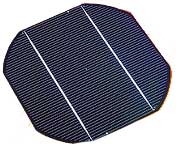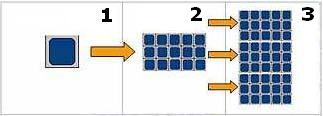The photovoltaic effect
|
|
Photovoltaic technology
allows to directly convert energy from solar radiation directly into electric energy, with an overall
efficiency![]() between 16% and 18% for a single monocrystalline photovoltaic
cell
between 16% and 18% for a single monocrystalline photovoltaic
cell ![]() .
.
This technology makes use of the photovoltaic effect which is based on the properties of certain semiconducting materials which can convert solar radiation energy into electric energy without the use of moving mechanical parts and without the use of fuel (Fig. 1).
These devices are made from
semiconductor![]() ,
materials, such as
silicon
,
materials, such as
silicon![]() (Si), gallium arsenide (GaAs) and copper sulphate (Cu2S). In a photovoltaic cell
(Si), gallium arsenide (GaAs) and copper sulphate (Cu2S). In a photovoltaic cell![]() , the
photons
, the
photons![]() of the incidental solar radiation break the ties of the semiconductor's electrons, thus
allowing the electrons to move freely in the semiconductor. The positions left
free by the electrons act as positive charges and take the name of "holes". The
photovoltaic cells generally consists of two thin regions, one above the other,
each with specially added impurities called dopants. The result is that one
region is of "type n"
of the incidental solar radiation break the ties of the semiconductor's electrons, thus
allowing the electrons to move freely in the semiconductor. The positions left
free by the electrons act as positive charges and take the name of "holes". The
photovoltaic cells generally consists of two thin regions, one above the other,
each with specially added impurities called dopants. The result is that one
region is of "type n"![]() , with an excess of electrons (negative), while the other is
of "type p", with an excess of positive holes. This 2-region structure, called a
p-n junction, produces an internal
electric
field
, with an excess of electrons (negative), while the other is
of "type p", with an excess of positive holes. This 2-region structure, called a
p-n junction, produces an internal
electric
field![]() . When the
photons create free electrons and holes in proximity to the p-n junction, the
internal electric field makes them move in opposite directions: the electrons
move towards the side n and the holes move towards the side p. So a tension (electromotive
force, e.m.f.) is generated between the p and n regions, with p positive and n negative.
Using wires, the side p and n are connected to a "load",
e.g. a light bulb, and an electric
current runs through the load.
. When the
photons create free electrons and holes in proximity to the p-n junction, the
internal electric field makes them move in opposite directions: the electrons
move towards the side n and the holes move towards the side p. So a tension (electromotive
force, e.m.f.) is generated between the p and n regions, with p positive and n negative.
Using wires, the side p and n are connected to a "load",
e.g. a light bulb, and an electric
current runs through the load.
|
|
Silicon in crystalline form is the
material most commonly used to make photovoltaic cells, which typically measure
12cm x 12cm. The cells are assembled together to obtain
photovoltaic
modules![]() with a surface of approximately half a metre squared (Fig. 2).
with a surface of approximately half a metre squared (Fig. 2).
Other types of cells are those in polycrystalline and amorphous silicon, which
are not as efficient, and those with more than two junctions, which are more
efficient but also more expensive. At the moment considerable efforts are being
made to develop plastic cells with polymers, which should have lower costs but
also reduced efficiency.
Photovoltaic systems are made
up of many panels connected in series and in parallel; this modularity permits
the systems to be highly flexible. A photovoltaic system can be a
stand
alone![]() system or a
grid
connected
system or a
grid
connected![]() ) system.
In both cases it is necessary to convert the continuous electric current supplied by the cells into alternate current through the use of an
inverter
) system.
In both cases it is necessary to convert the continuous electric current supplied by the cells into alternate current through the use of an
inverter
![]() .
.

